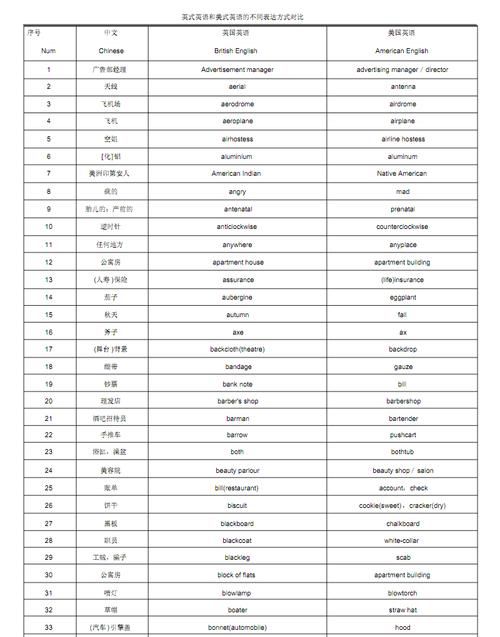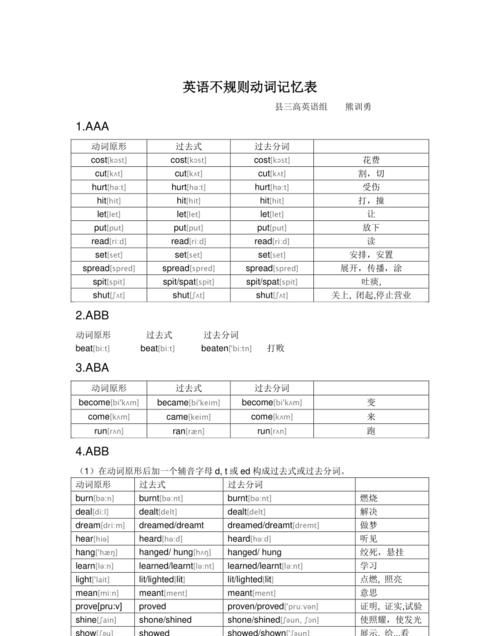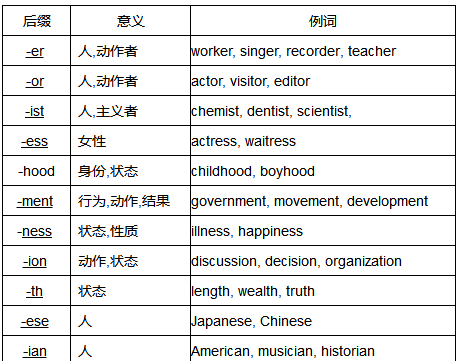本文目录
初二英语词形变化
英语单词形式的变化也就是名词单复数形式,或者是名词所有格。动词的单三现在分词过去式,过去分词。基数词,序数词。人称代词有主宾格,物主代词有形容词性的和名词性的。还有反身代词,形容词,副词,有比较级和最高级。这就是词性变化。

英语单词词性变形规律
英语单词词性变形方法 篇1
(1)v、—n、动词转化为名词,
post—postage mail—mail
weigh—weight advise—advice
(2)v、—n、—a、动词转化成名词—形容词
act—actor / actress—active
change—change—changeable
(3) v、—a、—ad、—n、动词转化成形容词,副词,名词
fill—full
need—necessary—necessarily
interest(v、 / n、) interested /interesting
(4)n、 a、 n、 a、名词转化为形容词
person personal ( 个人的; 私人的 )
fun funny
(5)n、 pl、 n、 pl、名词转化为名词复数
gentleman gentlemen human humans
(6)a、 ad、 a、 ad、形容词转化为副词
possible possibly probable probably
(7)a、 ad、 n、形容词转化为副词,名词
true truly truth
lucky luckily luck
(8)原级 比较级 最高级
far farther / further farthest / furthest
little less least
一、名词变为形容词的方法
1、 在名词后面加—y可以变成形容词(尤其是一些与天气有关的名词)。例如:rain—rainy, cloud—cloudy, wind—windy, snow—snowy, health—healthy, luck—lucky等。
注意:1)如果名词以重读闭音节结尾,且词尾只有一个辅音字母,这时应双写词尾的辅音字母再加—y。如:sun—sunny, fun—funny等。
2)少数以不发音的e结尾的名词变为形容词时,应去掉e再加—y。例如:noise—noisy, ice—icy 等。
2、 一些抽象名词在词尾加—ful可以变为形容词。例如:care—careful, thank—thankful, help—helpful, use—useful, beauty—beautiful等。
3、 一些表示国家的名词可以在词尾加—ese, —ish或—n构成表示国籍、语言的形容词。例如:China—Chinese, Japan—Japanese, England—English, America—American, India—Indian, Australia —Australian(注意Canada—Canadian)。
4、在名词后加—ous变为形容词。例如:danger—dangerous等。
5、 在名词后加—ly变为形容词。例如:friend—friendly, love—lovely等。
6、在名词后加—less构成含有否定意义的形容词。例如:care—careless(粗心的),use—useless(无用的),hope—hopeless(没希望的),home—homeless(无家可归的)等。
7、 一些以—ence结尾的名词,把ence改为ent变成形容词。例如:difference—different, silence—silent等。
二、动词变为名词的方法
1、词形不变,词性改变。例如:work, study, water, plant等可以用作动词,也可以用作名词。
2、 一些动词在词尾加上—er或—or之后就变成了表示“某一类人”的名词。例如:work—worker, teach—teacher, sing—singer, jump—jumper, play—player, learn—learner, visit—visitor, invent—inventor等。
注意:1)以不发音的e结尾的动词,在词尾加—r。例如:drive—driver, write—writer等。
2)以重读闭音节结尾,且末尾只有一个辅音字母的动词,应双写末尾的辅音字母,再加—er。例如:run—runner, win—winner, begin—beginner等。
3、 在动词词尾加—ing变成名词(方法与动词变为现在分词的方法相同)。例如: meet—meeting, build—building, wait—waiting, wash—washing, swim—swimming, shop—shopping, begin—beginning等。
三、形容词变为副词的方法
一般在形容词的词尾加—ly可以变成副词。例如:quick—quickly, slow—slowly, loud—loudly, sudden—suddenly 等。但是,以下几点值得注意:
1、 一些以“辅音字母+y”结尾的形容词,要把y改为i再加—ly。例如:happy—happily, angry—angrily, lucky—luckily, heavy—heavily, noisy—noisily 等。
2、 有些以—ble或—le结尾的形容词,去掉e加—y。例如:possible—possibly, terrible—terribly等。
3、 少数以e结尾的形容词,要去掉e再加—ly。例如:true—truly等。但绝大多数以e结尾的形容词仍然直接加—ly。例如:polite—politely, wide—widely等。
4、 以—l结尾的形容词变为副词时仍然要在词尾加—ly,而不是只加—y。除非是以—ll结尾的才在词尾只加—y。例如:usual—usually, careful—carefully, useful—usefully, full—fully等。
英语单词词性变形方法 篇2
一、词性的分类
词类又叫词性,英语单词根据其在句子中的功用,可以分成十个大类。
1 名词 noun n. student 学生
2 代词 pronoun pron. you 你
3 形容词 adjective adj. happy 高兴的
4 副词 adverb adv. quickly 迅速地
5 动词 verb v. cut 砍、割
6 数词 numeral num. three 三
7 冠词 article art. a 一个
8 介词 preposition prep. at 在...
9 连词 conjunction conj. and 和
10 感叹词 interjection interj. oh 哦
前六类叫实词,后四类叫虚词。
二、名词
名词概论
名词复数的规则变化
名词的格
在英语中有些名词可以加“‘s”来表示所有关系,带这种词尾的名词形式称为该名词的所有格,如:a teacher’s book。名词所有格的规则如下:
1) 单数名词词尾加“‘s”,复数名词词尾没有s,也要加“’s”,如the boy‘s bag 男孩的书包,men’s room 男厕所。
2) 若名词已有复数词尾-s ,只加“‘”,如:the workers’ struggle工人的斗争。
3) 凡不能加“‘s”的名词,都可以用“名词+of +名词”的结构来表示所有关系,如:the title of the song 歌的名字。
三、代词
代词pronoun简称pron是代替名词的一种词类。大多数代词具有名词和形容词的功能。英语中的代词,按其意义、特征及在句中的作用分为:人称代词、物主代词、指示代词、反身代词、相互代词、疑问代词、关系代词、连接代词和不定代词九种
人称代词的用法:
I saw her with them, at least, I thought it was her.
我看到她和他们在一起,至少我认为是她。(her做宾语,them做介词宾语,her作主补)
a. -- Who broke the vase?--谁打碎了花瓶?
b. -- Me.--我。(me作主语补语= It’s me.)
并列人称代词的排列顺序
1) 单数人称代词并列作主语时,其顺序为:
第二人称 -> 第三人称 -> 第一人称you -> he/she; it -> I
2) 复数人称代词作主语时,其顺序为:
第一人称 -> 第二人称 -> 第三人称we->you ->They
反身代词
指示代词
指示代词分单数(this / that)和复数(these / those)两种形式,既可作限定词又可做代词,
疑问代词
指人: who, whom, whose指物: what既可指人又可指物: which
代词比较辩异one, that和it
one表示泛指,that和it 表示特指。that与所指名词为同类,但不是同一个,而it 与所指名词为同一个。
I can‘t find my hat. I think I must buy one.(不定)
The hat you bought is bigger than that I bought.(同类但不同个)
I can’t find my hat. I don‘ t know where I put it.( 同一物)
四、冠词
冠词是印欧语系和闪含语系的诸语中,位于名词或名词词组之前或之后,在句子里主要是对名词起限定作用的词。冠词是一种虚词。
不定冠词a (an)与数词one 同源,是“一个”的意思。
定冠词的用法
定冠词the与指示代词this,that同源,有“那(这)个”的意思。
1)特指双方都明白的人或物:Take the medicine.把药吃了。
2)上文提到过的人或事: He bought a house. I’ve been to the house.
3)指世上独一物二的事物:the sun, the sky, the moon, the earth
4)单数名词连用表示一类事物,如:the dollar 美元;
the fox 狐狸;或与形容词或分词连用,表示一类人:the rich 富人; the living 生者。
5)用在序数词和形容词最高级,及形容词only, very, same等前面:
Where do you live? I live on the second floor.你住在哪?我住在二层。
6)与复数名词连用,指整个群体:
They are the teachers of this school.指全体教师)
They are teachers of this school.(指部分教师)
7)表示所有,相当于物主代词,用在表示身体部位的名词前:
She caught me by the arm..她抓住了我的`手臂。
8)用在某些由普通名词构成的国家名称、机关团体、阶级、等专有名词前:
the People‘s Republic of China中华人民共和国
9)用在表示乐器的名词之前:She plays the piano.她会弹钢琴。
10) 用在姓氏的复数名词之前,表示一家人:the Greens格林一家人 (或格林夫妇)
11) 用在惯用语中:
in the day, in the morning (afternoon,evening),the day after tomorrow
the day before yesterday, the next morning, in the sky (water,field,country)
in the dark, in the rain, in the distance, in the middle (of),in the end,
on the whole, by the way, go to the theatre
零冠词的用法
冠词与形容词+名词结构
1) 两个形容词都有冠词,表示两个不同东西。
He raises a black and a white cat.他养了一只黑猫和一只白猫。
2) 如后一个形容词无冠词,则指一物。
He raises a black and white cat.他养了一只花猫。
冠词位置
1) 不定冠词位置 不定冠词常位于名词或名词修饰语前。注意:
a. 位于下列形容词之后: such,what,many,half,
such an animal; Many a man
b. 当名词前的形容词被副词as, so, too, how, however, enough修饰时,不定冠词应放在形容词之后:It is as pleasant a day as I have ever spent.
c. quite,rather与单数名词连用,冠词放在其后。
但当rather,quite 前仍有形容词,不定冠词放其前后均可。如:quite a lot
d. 在as,though 引导的让步状语从句中,当标语为形容词修饰的名词时,不定冠词放形容词后: Brave a man though he is,he trembles at the sight of snakes.
当名词被比较级形容词修饰时,不定冠词通常置于比较级形容词之后。
2) 定冠词位置 定冠词通常位于名词或名词修饰语前,但放在all, both,double,half,twice,three times等词之后,名词之前。
All the students in the class went out.班里的所有学生都出去了。
五、数词
表示数目多少的数词叫基数词;表示顺序的数词叫序数词。
数词的用法
1)倍数表示法
a. 主语+谓语+倍数(或分数)+ as + adj. + as
I have three times as many as you.我有你三倍那么多。
b. 主语+谓语+倍数(分数)+ the size (amount,length…) of…
The earth is 49 times the size of the moon.地球是月球的49倍。
c. 主语+谓语+倍数(分数)+ 形容词(副词)比较级+ than…
The grain output is 8 percent higher this year than that of last year.
d. 还可以用by+倍数,表示增加多少倍
The production of grain has been increased by four times this year.
2)分数表示法
构成:基数词代表分子,序数词代表分母。分子大于1时,分子的序数词用单数,分母序数词用复数:1/3 one-third ; 3/37 three and three-sevenths
六、形容词及其用法
形容词(adjective),简称adj.或a.,很多语言中均有的主要词类中的一种。主要用来修饰名词的词,表示事物的特征。形容词用来修饰名词或代词,表示人或事物的性质、状态,和特征的程度好坏,与否。
形容词作定语修饰名词时,要放在名词的前边。但是如果形容词修饰以-thing为字尾的词语时,要放在这些词之后,例如:
something nice
以-ly结尾的形容词
1)friendly,deadly,lovely,lonely,likely,lively,ugly,brotherly,仍为形容词。
2)有些以-ly 结尾既为形容词,也为副词。
daily,weekly,monthly,yearly,early
The Times is a daily paper. The Times is published daily.
用形容词表示类别和整体
某些形容词加上定冠词可以泛指一类人,与谓语动词的复数连接。如:the dead,the living,the rich,the poor,the blind,the hungry
多个形容词修饰名词的顺序
限定词--数词--描绘词--(大小,长短,形状,新旧,颜色) --出处--材料性质,类别--名词
a small round table;a tall gray building;a dirty old brown shirt;a famous German medical school
七、副词及其基本用法
副词(adverb,简写为adv)是一种用来修饰动词、形容词、全句的词,说明时间、地点、程度、方式等概念的词。副词是一种半虚半实的词。副词可分为:地点副词、方式副词、程度副词、疑问副词和连接副词。
副词的排列顺序:
时间,地点副词,小单位的在前,大单位在后。
注意:副词enough要放在形容词的后面,形容词enough放在名词前后都可。
I don’t know him well enough.
There is enough food for everyone to eat. There is food enough for everyone to eat.
兼有两种形式的副词
1) close与closely
close意思是“近”; closely 意思是“仔细地”
He is sitting close to me. Watch him closely.
2)late 与lately
late意思是“晚”; lately 意思是“最近”
You have come too late. What have you been doing lately?
形容词与副词的比较级
八、动词
动词根据其后是否带有宾语,可分为两类,分别是:及物动词(Transitive Verb)、不及物动词(Intransitive Verb),缩写形式分别为vt. 和vi.。
在英语中按动词后可否直接跟宾语,可以把动词分成两种:及物动词与不及物动词。 及物动词 vt. 字典里词后标有vi. 的就是不及物动词。不及物动词后不能直接跟有动作的对象(即宾语)。若要跟宾语,必须先在其后添加上某个介词,如to,of ,at后方可跟上宾语。 及物动词: 又称“他动词”。又称“外动词”。动词的一种。它所表示的动作常涉及动作者以外的事物,如“吃”、“穿”、“读”、“写”等。字典里词后标有vt. 的就是及物动词。及物动词后必须跟有动作的对象(即宾语),并且可直接跟宾语。
不及物动词:字典里词后标有vi. 的就是不及物动词。不及物动词后不能直接跟有动作的对象(即宾语)。若要跟宾语,必须先在其后添加上某个介词,如to,of ,at后方可跟上宾语。具体每个动词后究竟加什么介词就得联系动词短语了
系动词
1)状态系动词:用来表示主语状态,只有be一词,例如:He is a teacher.
2)持续系动词:用来表示主语继续或保持一种状况或态度,主要有keep, rest, remain, stay, lie, stand, 例如:He always kept silent at meeting.他开会时总保持沉默。
3)表像系动词:用来表示“看起来像”这一概念,主要有seem, appear, look, 例如:
He looks tired.他看起来很累。
4)感官系动词:感官系动词主要有feel, smell, sound, taste, 例如:
This kind of cloth feels very soft. This flower smells very sweet.
5)变化系动词:这些系动词表示主语变成什么样,变化系动词有become, grow, turn, fall, get, go, come, run. 例如:He became mad after that.自那之后,他疯了。
6)终止系动词:表示主语已终止动作,主要有prove, turn out, 表达“证实”,“变成”之意,例如:The search proved difficult.搜查证实很难。
九、连词
连词是一种虚词, 它不能独立担任句子成分而只起连接词与词,短语与短语以及句与句的作用。连词主要可分为两类:并列连词和从属连词。并列连词用来连接平行的词、词组和分句。如:and, but, or, nor, so, therefore, yet, however, for, hence, as well as, both…and, not only…but also, either…or, neither…nor, (and)then等等。
not…but… 意思为“不是……而是……” not 和but 后面的用词要遵循一致原则。
They were not the bones of an animal, but (the bones) of a human being.
比较so和 such
其规律由so与such的不同词性决定。such 是形容词,修饰名词或名词词组,so是副词,只能修饰形容词或副词。so 还可与表示数量的形容词many,few,much, little连用,形成固定搭配。
so + adj.such + a(n) + n.
so + adj. + a(n) + n.such + n. (pl.)
so + adj. + n. (pl.)such +n. (pl.)
so + adj. + n. [不可数]such +n. [不可数]
so foolish ;such a fool so nice a flower;such a nice flower
so many/ few flowers;such nice flowers so much/little money;such rapid progress
so many people ;such a lot of people
十、介词
介词是一种用来表示词与词、词与句之间的关系的虚词,在句中不能单独作句子成分。介词后面一般有名词代词或相当于名词的其他词类,短语或从句作它的宾语。介词和它的宾语构成介词词组,在句中作状语,表语,补语或介词宾语。介词可以分为时间介词、地点介词、方式介词、原因介词和其他介词,
概念:
1)介词(是prepositions,简称prep),又称前置词,是英语中最活跃的词类之一,连接主语和表语。特别是一些常用介词的搭配力特别强,可以用来表示各种不同的意思。英语里大部分习语都是由介词和其他词构成的。介词在句中一般不重读。在定语从句“介词+who/which”的结构中,不能用that 代替who/which。She is a good student from who we should learn.
2)介词的种类 介词分简单介词和短语介词两种,简单介词及单个介词,如 in ,under ,on ,for ,after ,等,短语介词指多个单词构成的介词,如in front of ,out of ,instead of ,far from ,apart from 等。

英语单词复数形式变形规律总结举例
英语单词复数形式变形规律总结1
一、变内部元音
foot-feet
man-men
mouse-mice
tooth-teeth
woman-women
二、词尾加-en
child-children
ox-oxen
三、形式不变,即单复数同型(通形名词)
deer-deer
fish-fish
means-means
series-series
sheep-sheep
四、加-es(是加-s的'特殊情况)
match-matches
tomato-tomatoes
五、去y改i加-es或去f改v加-es(亦为加-s的特殊情况)
leaf-leaves
六、外来词的不规则变形
ovum-ova
locus-loci
basis-bases
(不少外来词有两种复数形式)
focus-foci/focuses
cactus-cacti/cactuses
fungus-fungi/funguses
英语单词复数形式变形规律总结2
规则 变形 :
1)一般情况下(大多数)词尾加s:
book→ books
pen → pens
bag → bags
teacher→ teachers
parent→ parents
tree→ trees
2)名词以s, x, sh, ch结尾时,(为了发音清晰)加es:
kiss→kisses
tax→ taxes(税)
brush→ brushes
lass→lasses(小姑娘)
box→ boxes
wish→ wishes
peach→ peaches
match→ matches
3)以o结尾的名词有些加es,有些加s:
tomato→ tomatoes
potato→ potatoes
echo→ echoes(回音)
hero→ heroes(英雄)
Negro→ Negroes(黑人)
veto→ vetoes(否决)
但以两个o或者两个元音字母结尾时只加s(如果再加es,则有ooe三个元音连在一起,不太好念。英语中很少允许三个元音字母在一起):
bamboos(竹)
radios
zoos
cuckoos(布谷鸟)
kangaroos(袋鼠)
studios(画室)
embryos(胚胎)
有些以o结尾的外来词只加s:
photos(照片)
solos(独唱 )
pianos(钢琴 )
kilos(千克 )
memos(备忘录)
Filipions(菲律宾人)
Eskimos(爱斯基摩人)
有些加s或者es都可以:
motto(e)s(座佑铭)
cargo(e)s(货物)
volcano(e)s(火山)
buffalo(e)s(水牛)
banjo(e)s(班卓琴)
tornado(e)s(龙卷风)
4)以“辅音字母+y”结尾时,改y为i,再加es(便于发音清晰):
city→ cities
country→ countries
county→ counties(县)
注意:“元音+y”结尾时不能改y,直接加s,因为如果改y为i, 整个词形和发音会产生很大影响:
√boy → boys
√toy → toys
√guy → guys
×box → bois
5)以f或者fe结尾的名词,多数变f为v再加es(为了发音清晰):
wife→ wives
self→ selves
loaf→ loaves (面包片)
wolf→ wolves (狼)
thief→ thieves
knife→ knives
shelf→ shelves (书架)
half→ halves
leaf→ leaves
但是,“两个元音字母+f”结尾时只加s(不能再变f为浊音v再加es,那样听起来会太硬):
roof → roofs(屋顶)
proof → proofs(证据)
chief → chiefs(首领)
hoof → hoofs(马蹄)
个别词两种形式都可以:
scarf→ scarfs, scarves(围巾)
dwarf→ dwarfs, dwarves(矮人)
handkerchief→ handkerchiefs, handkerchieves(手巾)

英语单词的词性转换规律
一、名词变为形容词的方法
1.在名词后面加-y可以变成形容词(尤其是一些与天气有关的名词)。例如:rain—rainy, cloud—cloudy, wind—windy, snow—snowy, health—healthy, luck—lucky等。
注意:1)如果名词以重读闭音节结尾,且词尾只有一个辅音字母,这时应双写词尾的辅音字母再加-y。如:sun—sunny, fun—funny等。
2)少数以不发音的e结尾的名词变为形容词时,应去掉e再加-y。例如:noise—noisy, ice—icy 等。
2. 一些抽象名词在词尾加-ful可以变为形容词。例如:care—careful, thank—thankful, help—helpful, use—useful, beauty—beautiful等。
3. 一些表示国家的名词可以在词尾加-ese, -ish或-n构成表示国籍、语言的形容词。例如:China—Chinese, Japan—Japanese, England—English, America—American, India—Indian, Australia —Australian(注意Canada—Canadian)。
4.在名词后加-ous变为形容词。例如:danger—dangerous等。
5. 在名词后加-ly变为形容词。例如:friend—friendly, love—lovely等。
6.在名词后加-less构成含有否定意义的形容词。例如:care—careless(粗心的),use—useless(无用的),hope—hopeless(没希望的),home—homeless(无家可归的)等。
7. 一些以-ence结尾的名词,把ence改为ent变成形容词。例如:difference—different, silence—silent等。
二、动词变为名词的方法
词形不变,词性改变。例如:work, study, water, plant等可以用作动词,也可以用作名词。
2. 一些动词在词尾加上-er或-or之后就变成了表示“某一类人”的名词。例如:work—worker, teach—teacher, sing—singer, jump—jumper, play—player, learn—learner, visit—visitor, invent—inventor等。
注意:1)以不发音的e结尾的动词,在词尾加-r。例如:drive—driver, write—writer等。
2)以重读闭音节结尾,且末尾只有一个辅音字母的动词,应双写末尾的辅音字母,再加-er。例如:run—runner, win—winner, begin—beginner等。
三、形容词变为副词的方法
一般在形容词的词尾加-ly可以变成副词。例如:quick—quickly, slow—slowly, loud—loudly, sudden—suddenly 等。但是,以下几点值得注意:
一些以“辅音字母+y”结尾的形容词,要把y改为i再加-ly。例如:happy—happily, angry—angrily, lucky—luckily, heavy—heavily, noisy—noisily 等。
2. 有些以-ble或-le结尾的形容词,去掉e加-y。例如:possible—possibly, terrible—terribly等。

扩展资料:
常用词性变换:
1.ability (n. )能力;才能---able (a.)---unable (a..) —disability (n. ) —disabled (a.)
be able to do…= be capable of doing
2.absence (n. ) 缺席;不在 --- absent (a.) ---present (a..) – presence (n.)
be absent from; be present at
3.absolute (a.) 绝对的;完全的---absolutely (adv.)
4.abundant (a.) 丰富的;充裕的 ---abundance (n.) be abundant in
5.academic (a.) 学院的,理论的 (n.) 大学教师 --- academy (n.) 学院
6.accept (v.) 接受---acceptable (a.)可接受的 - –refuse (opp.) 拒绝
7.access (n.) 通路,入门;(v.)接近;存取 ---accessible (a.)
have access to(to为介词)可以使用;可以接触
8.accurate (a.) 正确的,精确的 --- accuracy (n.) –accurately (adv.)-- (opp.)inaccurate 不准确
9.achieve (v.) 取得,达到 --- achievement (n.)
10.acquire (v.) 获得,学到 --- acquisition (n.)
11.act (n. ) 法令,条例;(v.)表演;行动---action (n.) –active (a.) 主动的 —inactive (a.) —actively (adv.) —activity (n. ) 活动 --passive (a.) 被动的 ---actor (n.) –actress (n.)
12.actual (a.) 实际的;现实的–actually (adv.) = as a matter of fact
13.adapt (v.) 使适应;改编 ---adaptation (n.) 适应,顺应;改编,改编本
---adaptable (a.) 有适应能力的adapt oneself to 适应于; adapt…(for sth.) from sth. 改编
14.add (v.) 添加,增加;补充说- --addition (n.) ---additional (a.) –additionally (adv.)
add…to 将…(添)加到… add to 增加,加强 add up加起来 add up to共计达
in addition (to) 另外,除此之外
15.addict (n.) 成瘾的人 ---addicted (a.) –addition (n.) ---addictive (a.) 使成瘾的;上瘾的;易令人沉溺的 be addicted to (to为介词)对…上瘾
16.adjust (v.) 调整,使适应 ---adjustment (n.) --- adjustable (a.)
17.admire (v.) 钦佩,羡慕 ---admiration (n.) --- admirable (a.)
18.admit (v.) 承认,准许 ( admitted, admitted) --- admission (n.)
19.adopt (v.) 收养,采用 ---adoption (n.) --- adopted (a.)
20.advance (v.) 推进,促进;前进 (n.)前进,提升—advanced (a.) 先进的;高等的
21.advantage (n.) 有点;好处 ---disadvantage (n.)
take advantage of利用;欺骗,占…的便宜
22.adventure (n.) 冒险,奇遇 --- adventurous (a.)
23.advertise (v.) 为…做广告---advertisement (n.)
24.advise (v.) 建议,劝告----adviser (n.) 顾问,忠告者 --- advice (n.) a piece of advice
25.affect (v.) 影响 --- affection (n.) 影响,感情 = have an effect on
26.Africa (n.) 非洲 --- African (a.) (n.)
27.age (n.) 年纪 --- aged (a.)老年的 —elderly (a.)
28.agree (v.) 同意--- agreement (n.) --- disagree (opp)—disagreement (n.)
29.agriculture (n.) 农业 – agricultural (a.)
30.allow (v.) 准许,允许---allowance (n.) 允许;紧贴,补助
31.amaze (v.) 惊奇, 震惊 --- amazement (n.) ---amazed (a.) –amazed (a.)
to one’s amazement
32.ambition (n.) 抱负,雄心---ambitious (a.)
33.amuse (v.) 使…快乐 --- amusement (n.) – amused (a.) --- amusing (a.)
to one’s amusement
34.analyze (v.) 分析 --- analysis (n.)
35.anger (n.) 愤怒 --- angry (a.)
36.announce (v.) 宣布, 宣告 --- announcement (n.) --- announcer (n.)
37.annoy (v.) 使烦恼 – annoyed (a.) --- annoying (a.) --- annoyance (n.)
to one’s annoyance
38.annual (a. ) 一年一次的,每年的 (n.) 年刊 --- annually (a.)
39.anxious (a.) 忧虑的,焦急的 --- anxiety (n.)
40.apologize (v.) 道歉 --- apology (n.)
apologize to sb. for sth.; make an apology to sb. for sth.因…事向某人道歉
41.appear (v.) 出现 ---appearance (n.)外貌,外观;出现,露面
42.apply (v.) 申请 , 应用--- application (n.) 申请表 --- applicant (n.) 申请人
--- applied (a.) 应用的
43.appoint (v.) 约定,任命 – appointment (n.) -----make an appointment 约会
44.appreciate (v.) 欣赏,感激 --- appreciation (n.)
45.approve (v.) 批准,同意 --- approval (n.) approve of…赞成
(opp.) disapprove (v.) 不赞成 disapprove of…
46.argue (v.) 争辩,辩论—argument (n.)
47.arrange (v.) 安排 --- arrangement (n.)
48.arrive (v.) 到达 – arrival (n.)
49.Asia (n.) 亚洲 ---Asian (a.) (n.)
50.assess (v.) 评价,估价 --- assessment (n.)
51.assist (v.) 帮助,协助--- assistance (n.) 帮助,援助 ---assistant (n.) 助手,助理
52.associate (v.) 联系,交往--- association (n.) --- associated (a.)
53.assume (v.) 假定,采取 --- assumption (n.)
54.astonish (v.) 使惊讶 --- astonished (a.) --- astonishing (a.) – astonishment (n.)
55.astronaut (n.) 宇航员 --- astronomy (n.) 天文学 --- astronomer (天文学家)
56.athlete (n.) 运动员 --- athletic (a.) 运动员的;运动的;体格健壮的;行动敏捷的
57.attend (v.)参加,照料 -- attendance (n.)出席,参加 - -attender (n.) 出席者;参加者
58.attention (n) 注意,专心--- attentive (a) –attentively (ad v.)
59.attract (v.) 吸引 – attraction (n.) --- attractive (a.)
60.aware (a.) 知道的,明白的 --- awareness (n.) be aware of
61.bacterium (n.) 细菌 ---(pl. ) bacteria
62.bad (a.) 坏的 --- badly (adv. ) (worse, worst) --- good (a.) – well (a.) (adv.) (better, best)
63.base (n.) 基地,根据地 (v.) 以…为基地 -- basic (a.) --- basically 大体上
64.basis (n.) 基础,要素 --- (pl.) bases
65.bath (n.) 洗澡,浴室—bathe (v.) – bathroom (n.) --- bathtub (n.) 澡盆
66.bear (v.) 忍受 (bore, borne)--- bearable (a.) 可忍受的 --- unbearable (opp.) 不可忍受的
67.beat (v.) 敲打,跳动,打赢 (beat, beaten)
68.beautiful (a.) 美丽的--- beauty (n. ) --- beautify (v.)
69.behave (v.) 行为,守规矩 --- behavior (n.)
70.belief (n) 信条,信念 ---(pl.) beliefs-- believe (v.) --- believable (a.) ---(opp.) unbelievable
71.begin (v.) 开始,着手 (began, begun)--- beginning (n.)
以上就是关于英语单词的变化形式,初二英语词形变化的全部内容,以及英语单词的变化形式 的相关内容,希望能够帮到您。
